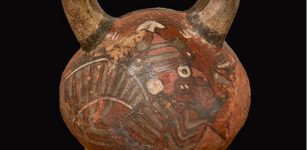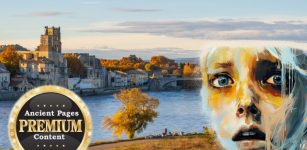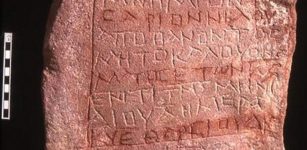Nefertum – God Of Lotus Blossom, Perfumes, Aromatherapy, Beauty In Egyptian Mythology
A. Sutherland - AncientPages.com - In the religion of the ancient Egyptians, Nefertum (in Greek: Iphtimis) is the personification of the refreshing and most beautiful smell, which, according to the myths, was to set free the creative energy of Re-Atum, and on this belief is based the connection of the name ‘Nefertum’ with Atum.
Aromatic oils used in rituals like mummification and anointing the deceased to ensure his eternal life possessed this smell.
Nefertum (Nefertem) was often believed to be the god of perfumes, but in the first place, he was the young and very handsome god of the lotus blossom, which has its beginnings in primeval waters. Especially blue Lotus (Nymphaea cerulean) plays a significant role in the Egyptian story of creation because the sun god, Ra, emerged from this flower. It all happened at the very beginning.
He is associated with the primordial lotus flower and mentioned as “the lotus blossom which is before the nose of Ra” in the Pyramid Texts (266) dated to c. 2350 BC and his importance continued, and he became an even more prominent deity during the New Kingdom (1539 BC-1075 BC and later.
This is a preview of our premium article available only to members of Ancient Pages.
Become a member to read more - Click here
If you are already a member and have logged in to your account, you can access the article here
See also:
Aaru – Field Of Reeds: Kingdom Of Osiris Was The Ancient Egyptian Paradise
Edfu Texts Reveal Secrets Of Predynastic Egypt And Zep Tepi
The Egyptian Dream Book Reveals Ancient Predictions Of The Future
Explore also: Ancient Pages Library Of Ancient And Unexplained Mysteries
More From Ancient Pages
-
 On This Day In History: Naval Battle Of Rennell Island Fought Off Guadalcanal – On Jan 29, 1943
News | Jan 29, 2017
On This Day In History: Naval Battle Of Rennell Island Fought Off Guadalcanal – On Jan 29, 1943
News | Jan 29, 2017 -
 What Can Ancient DNA From Copán Reveal About The Maya Collapse?
DNA | Jun 4, 2025
What Can Ancient DNA From Copán Reveal About The Maya Collapse?
DNA | Jun 4, 2025 -
 Colors On These Ancient Pots Hint At The Power Of An Empire
Archaeology | Mar 7, 2023
Colors On These Ancient Pots Hint At The Power Of An Empire
Archaeology | Mar 7, 2023 -
 Remarkable Ancient Statues From The Eye Temple – Unique Legacy From Tell Brak, Syria
Artifacts | Jul 20, 2018
Remarkable Ancient Statues From The Eye Temple – Unique Legacy From Tell Brak, Syria
Artifacts | Jul 20, 2018 -
 Was King William II Murdered In The New Forest?
Featured Stories | Aug 5, 2021
Was King William II Murdered In The New Forest?
Featured Stories | Aug 5, 2021 -
 2000 Ancient Gold Spirals Used By Sun-Worshiping Priest-Kings During The Bronze Age Discovered In Denmark
Archaeology | Jul 9, 2015
2000 Ancient Gold Spirals Used By Sun-Worshiping Priest-Kings During The Bronze Age Discovered In Denmark
Archaeology | Jul 9, 2015 -
 Unexplained Mystery Of The Dangerous Invisible Enemy In A French Town
Featured Stories | Feb 25, 2024
Unexplained Mystery Of The Dangerous Invisible Enemy In A French Town
Featured Stories | Feb 25, 2024 -
 Mysterious Figurine Of Seated Olmec Woman With Polished Hematite Disk
Artifacts | Sep 12, 2015
Mysterious Figurine Of Seated Olmec Woman With Polished Hematite Disk
Artifacts | Sep 12, 2015 -
 Mysterious Mount Roraima Surrounded By Myths And Clouds Of Dense Fog
Featured Stories | Nov 13, 2018
Mysterious Mount Roraima Surrounded By Myths And Clouds Of Dense Fog
Featured Stories | Nov 13, 2018 -
 Meskhenet: Egyptian Goddess Of Household And Childbirth Who Governed Over Fate And Destiny
Egyptian Mythology | Mar 14, 2019
Meskhenet: Egyptian Goddess Of Household And Childbirth Who Governed Over Fate And Destiny
Egyptian Mythology | Mar 14, 2019 -
 Dwarka – Pre-Harappan City That Could Rewrite The History Of The World
Civilizations | Aug 19, 2014
Dwarka – Pre-Harappan City That Could Rewrite The History Of The World
Civilizations | Aug 19, 2014 -
 Digesta: An Overlooked Source Of Ice Age Carbs
Archaeology | Apr 24, 2023
Digesta: An Overlooked Source Of Ice Age Carbs
Archaeology | Apr 24, 2023 -
 How Large Was The ‘Giant’ Dunkleosteus Terrelli – Prehistoric King Of The Oceans?
News | Apr 10, 2023
How Large Was The ‘Giant’ Dunkleosteus Terrelli – Prehistoric King Of The Oceans?
News | Apr 10, 2023 -
 Nabataean Culture Lived On Long After Their Kingdom Disappeared – New Evidence
Archaeology | Feb 27, 2019
Nabataean Culture Lived On Long After Their Kingdom Disappeared – New Evidence
Archaeology | Feb 27, 2019 -
 Mystery Of The Lydenburg Heads
Artifacts | Jun 13, 2014
Mystery Of The Lydenburg Heads
Artifacts | Jun 13, 2014 -
 Proof That Neanderthals Ate Crabs 90,000 Years Ago Is Another ‘Nail In The Coffin’ For Primitive Cave Dweller Stereotypes
Archaeology | Feb 7, 2023
Proof That Neanderthals Ate Crabs 90,000 Years Ago Is Another ‘Nail In The Coffin’ For Primitive Cave Dweller Stereotypes
Archaeology | Feb 7, 2023 -
 Climate Change Will Soon Erase Ancient Cave Art Of Sulawesi, Indonesia
Archaeology | May 17, 2021
Climate Change Will Soon Erase Ancient Cave Art Of Sulawesi, Indonesia
Archaeology | May 17, 2021 -
 Mystery Of The Artificial Cave And Ancient Encounters With Short People With Strange Feet
Ancient Mysteries | Mar 20, 2025
Mystery Of The Artificial Cave And Ancient Encounters With Short People With Strange Feet
Ancient Mysteries | Mar 20, 2025 -
 Medieval Grave And Skeleton With Arrow In Chest Unearthed In Ancient City Of Plovdiv, Bulgaria
Archaeology | Dec 28, 2017
Medieval Grave And Skeleton With Arrow In Chest Unearthed In Ancient City Of Plovdiv, Bulgaria
Archaeology | Dec 28, 2017 -
 On This Day In History: First Siege Of Rome Began – On March 2, 537
News | Mar 2, 2017
On This Day In History: First Siege Of Rome Began – On March 2, 537
News | Mar 2, 2017



